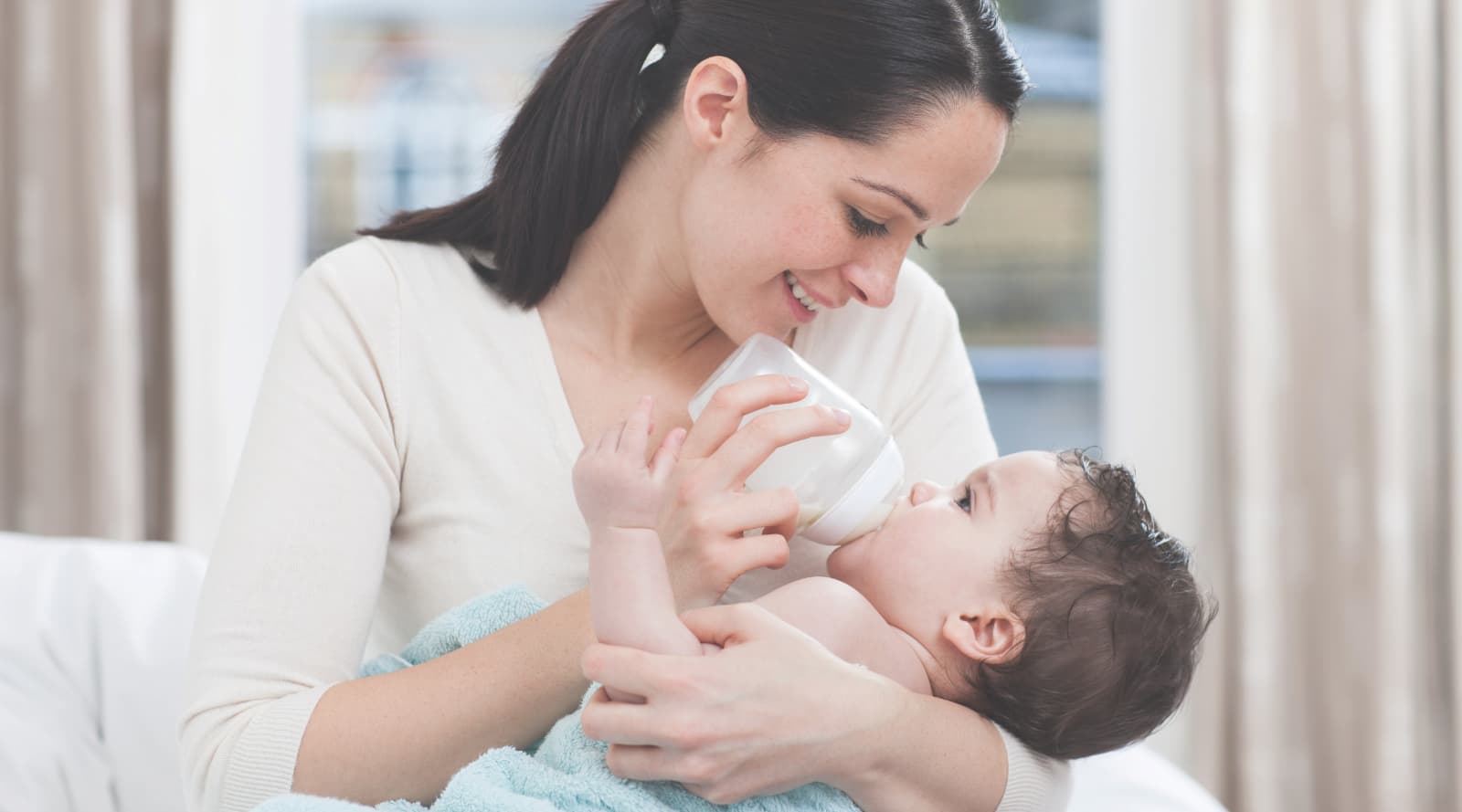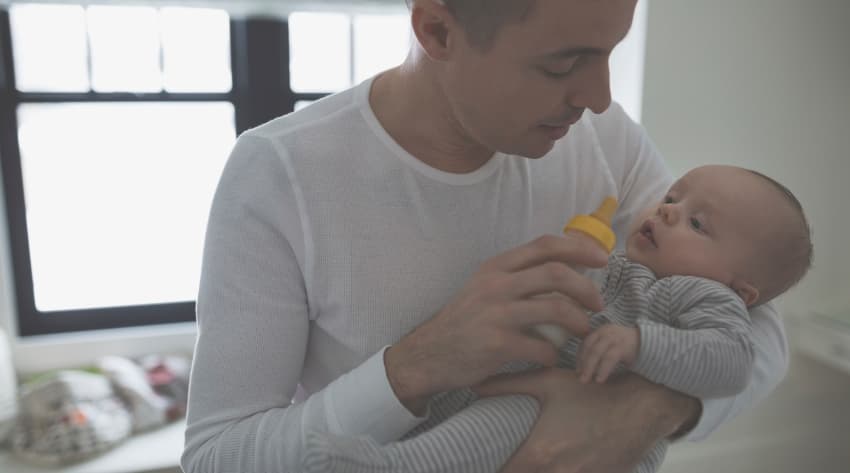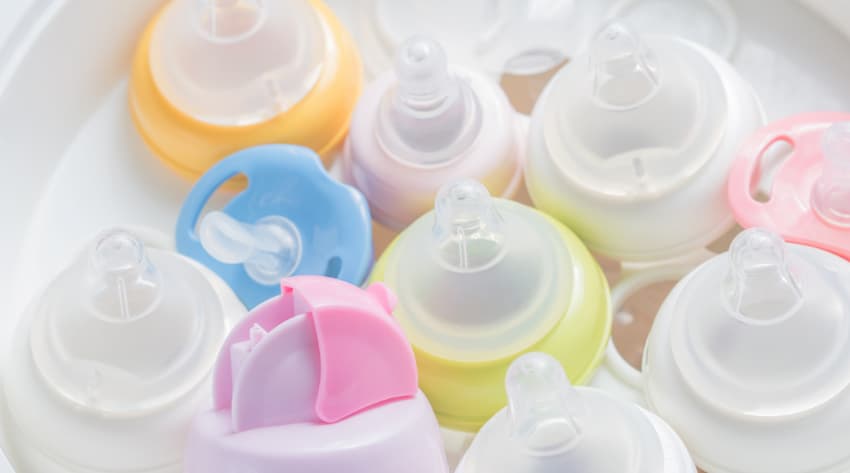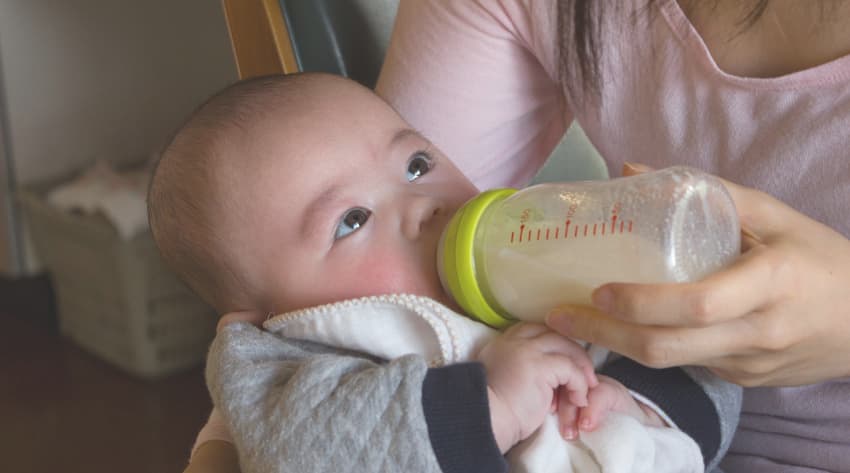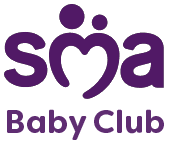Quick points for mum
Try using expressed milk first for a familiar taste
Give your breasts time to adjust to the change
And when supporting mum
Offer to do the first feeds until baby gets used to bottles
Hold the bottle at an angle to help prevent any wind
When to introduce a bottle
It’s recommended to breastfeed for as long as you can, however when breastfeeding isn’t possible, you can use formula to feed your baby. When making the decision to move from breastfeeding to formula feeding or combination feeding there are a few things to consider before doing so:
- Speak to your midwife, health visitor or a public health nurse if you’re thinking of introducing bottle feeding so they can provide you guidance.
- This is an emotional decision as well as a biological one. You need to balance the needs of you and your baby when making this decision. Introducing formula or even partial bottle-feeding may reduce the supply of breast milk which is biologically difficult to reverse.
- Formula feeding comes with some financial changes as well as changes in routines.
- If possible, make the change slowly so you and your baby have time to adjust. Removing just one breastfeed a week will give your body time to learn to produce less milk and will prevent your breasts from becoming engorged or leaking.
- You may need to express a little here and there, to relieve full breasts. Try not to express too much as that will over-stimulate milk production. It’s worth having some breast pads handy.
- If you choose to switch to formula you can do this at any time, however if you intend to combination feed with breastmilk and formula, it’s best to wait until 6 to 8 weeks until breastfeeding is fully established.
Combination feeding a newborn
Combination feeding means breastfeeding and bottle-feeding with the bottle containing either expressed breast milk or formula milk. It’s best to wait until breastfeeding is well established – any changes to breastfeeding routine may interfere with mum’s supply. Read our tips on how to introduce combination feeding
Signs baby is hungry (baby-led feeding)
When you introduce your baby to a bottle, look out for their little signs that tell you when they’re hungry or full. Understanding their feeding cues is a key part of responsive, or baby-led feeding and will help you know when your baby needs to feed or when they’ve had enough. It also helps you build an even stronger bond. We’ve made a series of responsive feeding videos to show you the most common feeding cues.
Bottle feeding equipment
Before you start bottle feeding your newborn there are a few basic items you need to get going. Babies tend to have around 6 feeds a day, so it’s worth having enough equipment for these feeds to allow time for sterilising. You don’t want to keep a hungry baby waiting!
- Six baby bottles so you always have a bottle ready in between sterilising
- Infant formula
- Six teats
- Sterilising equipment
- Bottle and teat cleaning brush
Recommended bottles for babies
It seems there are as many different types of bottle and teat as there are babies, but you’ll work out what’s right between the two of you. Here’s a quick guide on what to look out for:
Shape
Orthodontic teats are shaped to encourage correct oral development, while nipple-shaped teats are useful for breastfed babies who are combination feeding
Material
Silicone lasts longer, but latex teats are softer making them easier to start with
Flow
The teat hole size allows milk to flow at different rates. Too big and the milk will come out too fast. Too small, and it takes too much work to get the milk out. Each teat manufacturer has their own flow system but generally speaking, slow is for newborns, medium for 3+ months, fast for 6+ months old, and variable adjusts to the baby’s sucking action and is suitable for thicker or special formulas
Anti-colic bottles
These have air vents, tubes or collapsible bags to reduce how much air your baby takes in. A variable flow teat may also be helpful.
How to make up formula
How much formula should I give my baby?
Babies, just like the rest of us, have different appetites and they change over time. Make sure you follow the instructions on the pack when preparing the bottle. And if your baby was premature follow the advice of your healthcare professional. See the more detailed feeding guide below as an example.
Feeding guide
Birth - 12 months
| Approx. age of baby | Approx. weight of baby | Preparation for single feeds | Cooled, freshly boiled water | Feeds in 24 hrs |
|---|---|---|---|---|
|
||||
| kg | Level scoops | ml | ||
| Birth – 2 weeks | 3.4 | 3 | 90 | 6 |
| 2 – 4 weeks | 3.7 | 4 | 120 | 6 |
| 4 – 8 weeks | 4.2 | 4 | 120 | 6 |
| 2 months | 5.3 | 5 | 150 | 5 |
| 3 months | 6.1 | 6 | 180 | 5 |
| 4 months | 6.7 | 6 | 180 | 5 |
| 6 months | 7.6 | 8 | 240 | 4 |
| 7 – 12 months | - | 7 | 210 | 3 |
| Approx. age of baby | Approx. weight of baby | Preparation for single feeds | Cooled, freshly boiled water | Feeds in 24 hrs |
|---|---|---|---|---|
|
||||
| lb | Level scoops | fl. oz. | ||
| Birth – 2 weeks | 7 ½ | 3 | 3 | 6 |
| 2 – 4 weeks | 8 | 4 | 4 | 6 |
| 4 – 8 weeks | 9 ¼ | 4 | 4 | 6 |
| 2 months | 11 ¾ | 5 | 5 | 5 |
| 3 months | 13 ½ | 6 | 6 | 5 |
| 4 months | 14 ¾ | 6 | 6 | 5 |
| 6 months | 16 ¾ | 8 | 8 | 4 |
| 7 – 12 months | - | 7 | 7 | 3 |
This table is a guide only; your baby may need more or less than the volumes stated. If you require more advice, consult your healthcare professional. Remember to feed your baby on demand.
How to make up formula for a bottle feed
It’s best to make up each feed as and when you need it. Read the instructions on the product packaging before starting.
- Wash hands well. Sterilise all utensils according to manufacturers’ instructions
- Boil one litre of fresh tap water. Allow boiled water to cool for no more than 30 minutes. Measure the required amount of water and powdered product (see preparation instructions on the label) into the sterilised bottle, carefully – the water is hot. Do not use artificially softened or repeatedly boiled water
- Place the sterilised teat and cap on the bottle and shake well. Cool the bottle under cold running water or in a bowl or jug of cold water until milk is lukewarm. Test the temperature by shaking a few drops onto the inside of your wrist
- For hygiene reasons, discard unfinished feed in the bottle as soon as possible and always within one hour
Can I make up bottles ahead of time?
It is recommended that a powdered formula feed should be made up as and when you need it, but that’s not always possible when you’re out and about or when going to childcare, so here’s some guidelines:
- Take a bottle of made up formula you’ve chilled in the fridge for at least one hour. Pack it in a cool bag with an ice pack. Use within four hours
- Alternatively, fill a vacuum flask with boiling water. Measure scoops of formula into a sterile container. Mix the formula in sterile bottles using the water – make sure it’s still hot. Cool the milk and use within one hour, testing it on your wrist before feeding your baby
- When you are out and about you can always try ready to use liquid formula
How to bottle-feed a newborn
Steps to follow when introducing a bottle:
- Position your baby on your lap so they’re fairly upright, with their head supported so they can breathe and swallow comfortably
- Brush the teat against your baby’s lips. Once they open their mouth wide with their tongue down it’s a good time to help them get the teat into their mouth
- Tilt the bottle slightly as your baby drinks so the end of the teat is always full of milk and not air
- You’ll see bubbles inside the bottle as your baby feeds, if you can’t see any bubbles or the teat goes flat, gently move the teat around their mouth
- Never leave your baby alone to feed with a propped-up bottle as they may choke on the milk.
- Throw away any unused milk after the feed
Some babies take to bottle-feeding straightaway, others need a little gentle encouragement. To help you out we’ve compiled some advice to help you and baby adjust:
- If possible, start bottle-feeding with some expressed breast milk, to help baby adapt to the bottle
- Some babies will refuse a bottle and expect a breastfeed if they can smell mum nearby. So try letting someone other than mum give the first feeds
- Just in case the bottle causes upset, don’t wait until your baby is very hungry – they’ll only get more frustrated
- It may help to hold your baby in a different position than the usual breastfeeding position
- Try different teats – there are lots of different types and designs, and it may take some trial and error to find the one your baby prefers
- If your baby makes a really big fuss, take a break for a few days before trying again. Eventually your baby will get used to the bottle
For more bottle-feeding tips go to our Mother of all Checklist app
IMPORTANT NOTICE:
We believe that breastfeeding is the ideal nutritional start for babies and we fully support the World Health Organization’s recommendation of exclusive breastfeeding for the first six months of life followed by the introduction of adequate nutritious complementary foods along with continued breastfeeding up to two years of age. We also recognise that breastfeeding is not always an option for parents. We recommend that you speak to your healthcare professional about how to feed your baby and seek advice on when to introduce complementary feeding. If you choose not to breastfeed, please remember that such a decision can be difficult to reverse and has social and financial implications. Introducing partial bottle-feeding will reduce the supply of breast milk. Infant formula should always be prepared, used and stored as instructed on the label in order to avoid risks to a baby’s health.



